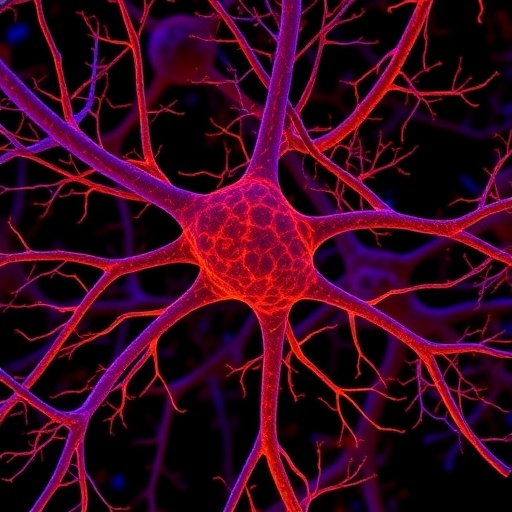In the intricate world of neuroscience, the symbiotic relationship between neurons and glial cells forms the foundation of brain function and resilience. While these cell types have long been recognized for their individual roles within the nervous system, recent research unveils a provocative new avenue for understanding how these cellular partnerships evolve, especially in the context of aging. A groundbreaking study published in Nature Neuroscience by Wu and colleagues reveals a novel communication mechanism whereby neurons transmit protective proteins directly to glia, orchestrating cellular responses that could redefine our understanding of brain aging.
Neurons and glia have historically been viewed as distinct entities, with neurons responsible for electrical signaling and glia serving primarily supportive roles. However, emerging evidence dismantles this simplistic view, unveiling glia as dynamic contributors to neural circuitry maintenance and modulation. The current research shifts this understanding further by demonstrating that neurons actively send molecular signals to glia using extracellular vesicles—nano-sized packets capable of shuttling proteins and RNA—thereby influencing glial function at a distance.
Focusing on the nematode Caenorhabditis elegans, an organism prized for its transparent anatomy and genetic tractability, the investigators pinpointed the amphid sensory organ as a model system for dissecting neuron-glia interactions. Intriguingly, they observed that sensory neurons within this organ age heterogeneously, presenting differential rates of functional decline. This observation led them to hypothesize that intercellular communication between neurons and glia might mediate these diverse aging trajectories.
.adsslot_Xil5j2z6ks{ width:728px !important; height:90px !important; }
@media (max-width:1199px) { .adsslot_Xil5j2z6ks{ width:468px !important; height:60px !important; } }
@media (max-width:767px) { .adsslot_Xil5j2z6ks{ width:320px !important; height:50px !important; } }
ADVERTISEMENT
The activation of this glial signaling cascade stimulates the transcription of genes coding for chondroitin synthases, enzymes involved in synthesizing chondroitin sulfate proteoglycans. These molecules contribute to the extracellular matrix architecture surrounding neurons, providing a neuroprotective environment that buffers against aging-related degradation. This neuron-to-glia signaling axis thus forms a feedback loop that enables glial cells to adapt their protective functions in response to neuronal aging.
Understanding the mechanics of extracellular vesicle-mediated protein transfer in this context reshapes how we envision intercellular dialogue in the nervous system. Extracellular vesicles, including exosomes and microvesicles, have gained attention for their roles in intercellular communication across various tissues. Here, their utility is unveiled as vehicles for direct protein transfer that modulates gene expression and rejuvenates glial support functions during the aging process.
The choice of the C. elegans model is strategic, leveraging its well-characterized sensory neurons and glia, combined with advanced molecular tools that reveal dynamics invisible in more complex organisms. Such insights bear translational potential, suggesting that similar neuron-glia communication networks could exist in higher organisms, including humans, influencing neurodegeneration and brain aging.
Moreover, the engagement of heat shock proteins as signaling molecules provides a fresh perspective on their physiological roles. Rather than merely acting intracellularly to refold misfolded proteins, HSPs dispatched through vesicles represent a form of stress communication that coordinates cellular defenses across cell types. This conceptual advance broadens the framework within which we understand proteostasis networks in brain aging.
The study also highlights the importance of the IRE1–XBP1 axis in glial cells. This pathway, a key player in the unfolded protein response, safeguards cellular function by resolving endoplasmic reticulum stress. Its activation through neuron-derived signals underscores a cooperative system where neurons and glia share burdens of proteostasis maintenance, adjusting their states dynamically in response to aging cues.
Crucially, the upregulation of chondroitin synthases in glia initiates structural remodeling of the extracellular environment. Chondroitin sulfate proteoglycans participate in modulating plasticity and protection within the nervous system. By linking molecular signaling with extracellular matrix synthesis, the study connects intracellular stress responses to broader tissue-level resilience.
This research also raises fascinating questions about the temporal dynamics of aging across different neuronal populations. Why particular sensory neurons age at different rates dependent on glial crosstalk opens avenues for exploring heterogeneity in neurodegenerative vulnerability. Targeting these intercellular signaling pathways may one day inform therapeutic strategies to delay or mitigate age-related cognitive decline.
The implications extend to understanding neuroinflammatory pathways, given that glial cells orchestrate immune responses within the brain. Modulation of glial states by neuron-derived HSPs could influence inflammatory profiles, impacting disease progression in conditions like Alzheimer’s and Parkinson’s diseases, where defective proteostasis and glial dysregulation are prominent.
The elegance of this study lies in its integration of cellular biology, molecular neuroscience, and aging research, showcasing a previously hidden level of complexity in nervous system communication. It suggests that maintaining brain health over the lifespan depends on the sophistication of intercellular signaling, with extracellular vesicle-mediated protein transfer emerging as a crucial mediator.
Looking ahead, these findings invite further inquiry into whether artificially enhancing neuron-to-glia HSP transfer or mimicking its effects could bolster neuroprotection. Such approaches could open innovative therapeutic avenues, transforming aging from an inexorable decline into a manageable process.
Subject of Research: Neuron-glia communication mechanisms during aging in Caenorhabditis elegans, focusing on heat shock protein-mediated signaling and glial activation pathways.
Article Title: Heat shock proteins function as signaling molecules to mediate neuron–glia communication in C. elegans during aging.
Article References:
Wu, J., Yarmey, V.R., Yang, O.J. et al. Heat shock proteins function as signaling molecules to mediate neuron–glia communication in C. elegans during aging. Nat Neurosci (2025). https://doi.org/10.1038/s41593-025-01989-0
Image Credits: AI Generated
Tags: brain aging mechanismsCaenorhabditis elegans modelcellular aging responsesextracellular vesicle communicationglial cell dynamicsHeat shock proteinsNature Neuroscience studyneurobiology of agingneuron-glia interactionneurons and glia symbiosisneuroscience research breakthroughsprotective protein signaling





